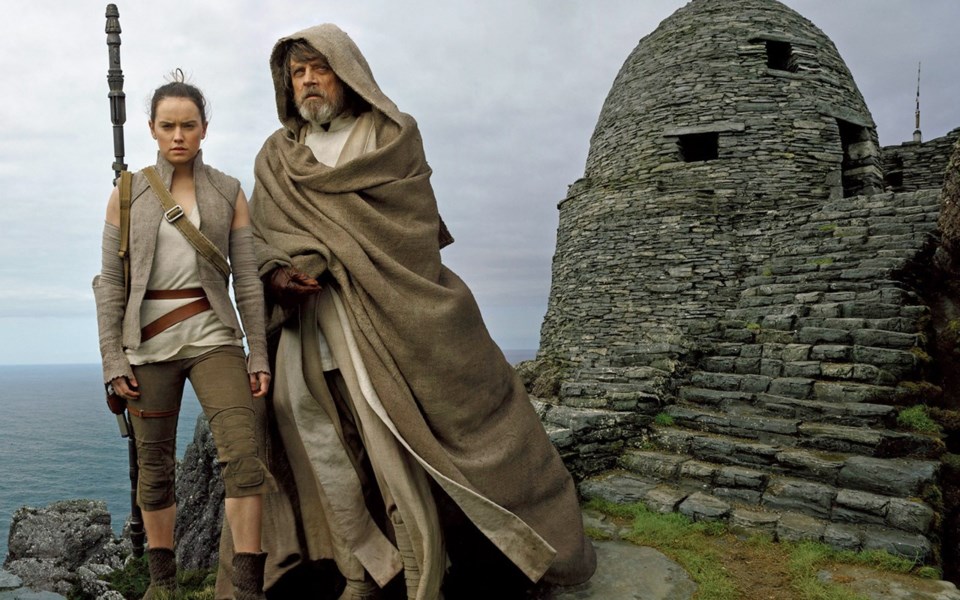Once upon a time in a galaxy far, far away...
Star Wars: Mark Hamill Still Over-Acts comes out this week, the ninth feature film in the universe's most beloved cosmic franchise. And the good news is, four decades later, Star Wars: The Last Jedi (actual title) is pretty awesome. Writer-director Rian Johnson (Brick, Looper) transcends both the franchise nostalgia and high expectations by piecing historical parts together into a new ship, then giving it the emotion it needs to blast into battle, and beyond.
The core story belongs to Rey, the young woman infused with Jedi power-funk (I still think she's Ben Kenobi's granddaughter) and now-old, scruffy (and still whiny) Luke Skywalker. With some brooding/creepy Kylo Ren (Han Solo's kid who killed Han Solo) tossed in there to ensure that dark side-light side dichotomy. Since film No. 1 (a.k.a.: Episode IV), the Star Wars story has always been about the balance between hope and despair sloshing around in the big dipper of existence. The Last Jedi rides that wave to surprisingly satisfying effect.
A secondary plotline involves ace pilot Poe Dameron learning the difference between a hero and a leader, while defected Stormtrooper Finn and his new smarter-than-him friend Rose get a (sometimes a bit extraneous) side mission of their own.
In her final role, O.G. Princess Leia, the late Carrie Fisher, leads the resistance, with Laura Dern appearing as a long-necked Rebel fleet commander. Shifty-eyed Benicio Del Toro pinch hits as some kind of vagabond safe cracker. There's also an epic, extended wide-shot lightsabre battle that's better than anything the franchise has done since Luke and Vader duelled in the rafters of Cloud City.
Granted, The Last Jedi is 152 minutes long (which is hefty for anyone this side of Tarantino), and some of the dialogue is a reminder that this has always been a franchise primarily aimed at children — it's an adventure first and foremost. Rian Johnson has always been a visionary director (like them or not, Brick and Looper both take place in fully realized and unique worlds), and given the most famous cinematic universe of them all, he knocks this one over the intergalactic fence.
The first Star Wars flick came out in 1977, but that very same year some pretty next level space shit went down in our own galaxy. NASA launched the Voyager 1 and 2 spacecraft that year with the primary objective of beaming back info about Jupiter and Saturn. Both missions were rote with drama but ended up an overwhelming success. The Voyager spacecraft are now well beyond Pluto, out in deep space boldly going where no man (or anything man-made) has gone before.
But that's not what makes them awesome. The kicker, the coolest thing of all, is that on the chance that either craft would bump into alien life forms, NASA sent a message out with each ship — they made a pair of golden records. An actual record like you would play on your home stereo! But made of gold, radiated with uranium-238 (aliens can tell how old the record is by back dating the half-life of the uranium molecules on it) and full of key images, stories, sounds, greetings, and music from Earth.
Most of the music is classical (Bach, Beethoven, etc.) or native music from around the world (pygmy initiation song, Peruvian panpipes, etc.) but there are a couple tracks of contemporary music that made the cut — the heart-moving blues-gospel guitar hymn "Dark Was The Night (Cold Was The Ground)" by Blind Willie Johnson, and Chuck Berry's "Johnny B. Goode."
The project was spearheaded by astronomer Carl Sagan, as a follow up to an informative plaque that went out on previous spacecraft. Sent out with a stylus (record needle) and engraved instructions on how to play it (speed, direction, positioning, etc.), the record also included Earth's location on a pulsar map in case any of the E.T.s out there wanted to come jam.
The Farthest: Voyager in Space is available on Netflix and is one of the best science docs of the year. While the Golden Record is only a small part of the Voyager story, it's also an early example of digital multimedia delivered in an analog format — to aliens. In the film, Sagan quotes Scottish intellect Thomas Carlyle's thoughts on the stars: "A sad spectacle. If they be inhabited, what a scope for misery and folly. If they be not inhabited, what a waste of space."
Inside sources say NASA received a response from deep space earlier this year: "Send more Chuck Berry."




